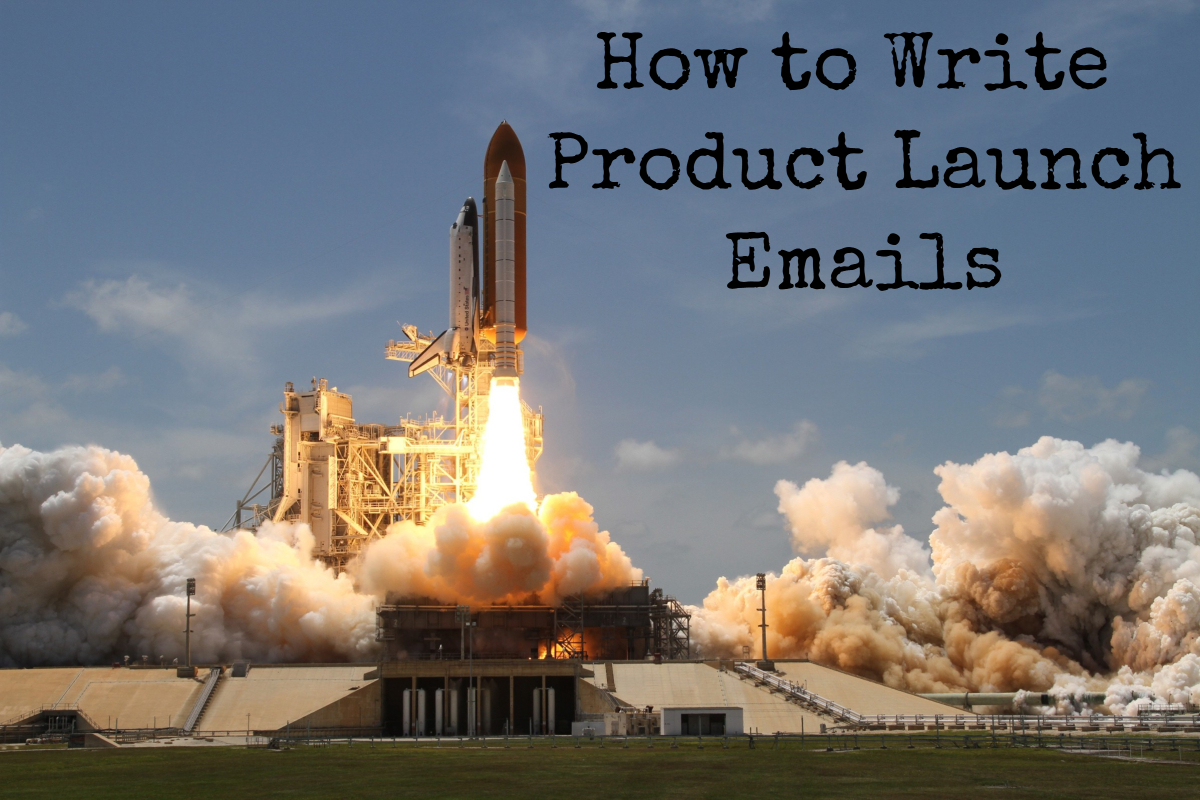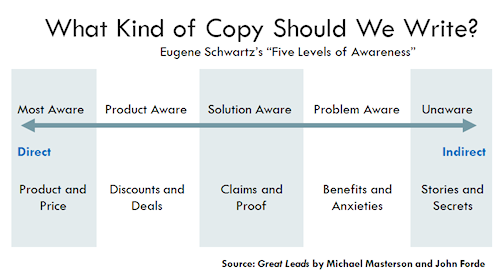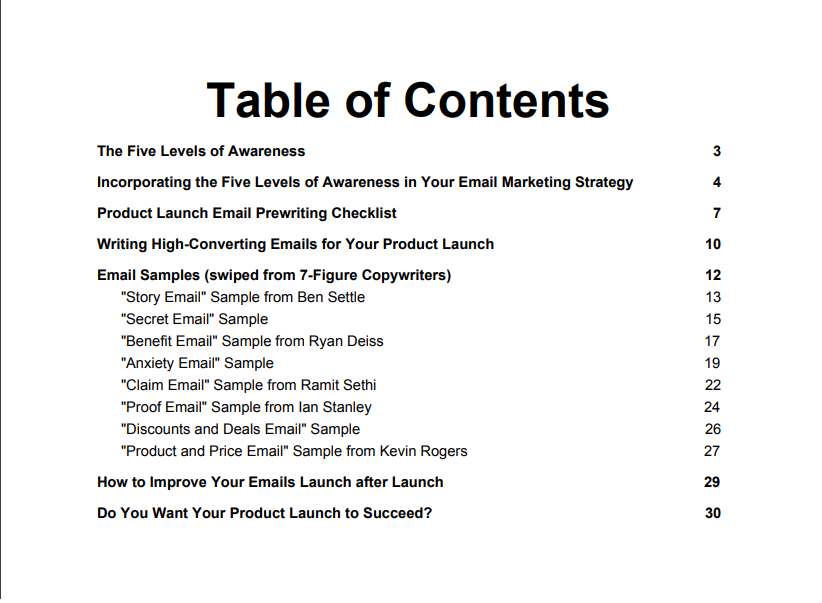How to Write Product Launch Emails that
Generate Massive Sales and Conversions
…especially if it’s your first time or your past emails didn’t convert as expected.
There are a lot of moving parts in a launch. You need to make sure your sales message is on point. It needs to be congruent from your ad to the landing page to the emails to the PLCs, webinar, and sales page.
Not only that, but you also have to make sure your prospect’s buying journey is engaging, emotional, and exciting.
If not? You can kiss your sales goodbye.
Which begs the question…
What does a successful product launch email look like?
What does it take to write high-converting product launch emails?
How do you make sure it’s successful?

In this post, I’m going to answer all three questions…
The complicated route is, of course, where you automate, use sophisticated email marketing software, and hire a copywriter.
Today, I want you to choose the simple road. The DIY-style way of writing product launch emails.
Don’t worry. This road isn’t less effective than the complicated one. You just have to do more work and put in more hours. But you’ll be glad that you did.
The simple road can be more effective in the right hands — or in our case, in the right copywriter.
Here’s what I can promise you after reading this entire post:
🚀 You’ll be able to write 7-8 emails for your product launch
🚀 You can write each email in under 60 minutes (longer if you’re a beginner)
🚀 You’ll write better and better emails after each launch.
Excited? So am I.
So let’s start. Shall we?
The 5 Levels of Awareness
Assuming you don’t, here’s a quick summary:
The Five Levels of Awareness is a concept introduced by Eugene Schwartz. It follows the buying journey of every customer you will ever meet.
There are five levels: Unaware, Problem Aware, Solution Aware, Product Aware, and Most Aware.
📌 “Unaware” prospects don’t know who you are, what you do, and why you do it — basically they know nothing about you. Every customer you’ll ever have will start on this level.
📌 “Problem Aware” prospects know they have a problem. But they don’t know a solution exists.
📌 “Solution Aware” prospects understand they have a problem and knows a solution exists. These are prospects who are actively seeking for answers. They’re the type who goes on Google to search for DIY solutions.
📌 “Product Aware” prospects understand their problem, know all the solutions available, and also knows who sell these solutions. They’re shopping around, scouting, looking for the best deals.
📌 “Most Aware” prospects are already customers that bought from you. No need to persuade them. They’ll buy almost anything you put out. The perfect example is Apple users.
So….how does knowing this help you write better product launch emails?
Incorporating the Five Levels of Awareness in Your
Email Marketing Strategy
That’s why you need to know if your prospects are Unaware, Problem Aware, Solution Aware, Product Aware, or Most Aware.
Because the language you use matters
Let’s have a quick example…
Let’s say you’re selling a Traffic Generation Training Course. When you talk to Unaware prospects about “traffic”, they’ll think cars, the highway, and traffic lights.
So instead of using “traffic” you say “people.”
Which do you think will make more sense to an Unaware Prospect (a complete newbie to Internet Marketing)…
Sentence #1: Do you want to drive traffic to your website?
Sentence #2: Do you want to bring people to your website?
See how a little tweak can mean so much? That’s why it’s important you fully grasp Eugene Schwartz’s Five Levels of Awareness.
So that’s…
Step #1: Find the Awareness Level of Your Prospects
Know what they already know. What books do they read? Blogs they visit? Gurus they follow? Knowing these facts can help you identify which Awareness Level they’re at. More importantly, what kind of language they use to describe their situation, pain, and problem.
Step #1 is the easy part. Step #2 is a bit harder.
It’s because you have to bring them from where they’re at to where you want to be. And the level you want them to be in is the 4th or 5th level of the awareness scale.
How exactly do you do that?
Let me introduce to you the solution…

Step #2: Write Sales Copy that Matches Your Prospects’ Awareness Level
In the book “Great Leads”, Michael Masterson and John Forde identified 6 lead types. The lead you choose depends on your prospects’ awareness level.
Quick side note: the “lead” is the first few paragraphs of your sales copy. So it includes your headline (in our case, subject line) and the first few opening sentences.
The book is must-have for any serious copywriter. If you don’t have the yet, just look at the image. It summarizes what kind of lead you need to write to effectively reach each awareness level.
If your prospects are Unaware, use stories and secrets in your email. If they’re Problem Aware, weave benefits and anxieties in your email. So on and so forth.
However…
Step #2 won’t work unless you do step #3.
Step #3: Move Prospects from One Awareness Level to Another…
There must be a progression. If they’re Problem Aware from the beginning, here’s what your emails will look like leading up to the launch:
Email #1: Benefits and Anxieties (Problem Aware)
Email #2: Claims and Proof (Solution Aware)
Email #3: Deal (Product Aware)
Email #4-7: Follow-up Emails
Or you can do this…
Email #1: Anxieties
Email #2: Benefits
Email #3: Claims
Email #4: Proof
Email #5: Deal
Email #6-9: Follow-up Emails
Once you’ve performed Step #1 to #3, congrats! You already have an email marketing strategy!
But it’s not done yet.
Remember, this is just the strategy part. We haven’t crossed to the copywriting part yet. That’s what we’ll do in the next section…
Product Launch Email Pre-writing Checklist
Well, me too. That’s why I have a ritual. A process. A checklist I go through to make sure I can write the best damn emails for my client’s product launch.
WARNING: this is not a one-size-fits-all checklist, okay? You can eliminate a few things. You can also add a few items. Create a process that works for you.
For me, answering this checklist puts my mind in the right state so I can write effective emails. So without further delay…
Here’s my pre-writing checklist (AKA info I need to write emails that convert):
- What’s your prospects’ awareness level? (CHECK!)
- What’s your hook?
- What’s your USP?
- Your first lead idea? (CHECK!)
- What’s their common myths and misconceptions?
- Bullets of your product
- Your prospects wants, needs, frustrations, dreams, goals, and fears.
Now that’s a lot, right? Let’s go each item briefly.
✅ The Hook is where you must pique their interest. You must give them a reason to keep on reading.
Here’s a quick example:
In the summer of ‘08, I was the leading scorer in my team. The coach ran plays for me. My teammates trusted me. We were winning.
It was smooth sailing until we faced the 3-time division champs…
See that?
It got you curious. You want to know what’s going to happen next.
That’s the job of your hook.
By the way, your job is not to sell on the first few lines. Your job is to make sure your prospect reads the next line.
You want them to read the subject line, then the first line, and then the next line, then the next, until they hit your call-to-action.
That’s it!
✅ USP means Unique Selling Proposition. What sets your product apart from your competitors? Is it stronger, better, faster? Is it the first of its kind? Is it the only product that solves a specific pain faster?
If you can’t answer this, you’ll have a hard time selling a product. I’m not saying you can’t sell. I’m saying it’ll be difficult.
You don’t need this until the Product Aware emails. But it’s good to have this in mind while you’re writing emails for your Unaware, Problem Aware, and Solution Aware prospects.
Here’s why:
For example, your Unique Selling Proposition is that your pill (product) is the fastest way to cure tonsillitis. In 5 minutes, it’s gone. You’re completely healed. No side effects.
This is what your product launch emails will look like:
Email #1: Anxieties – the frustration of having tonsilitis
Email #2: Benefits – benefits of not having tonsilitis
Email #3: Claims – cure tonsillitis in 5 minutes
Email #4: Proof – scientific research
Email #5: Deal – product reveal
Email #6-9: Follow-up emails
✅ The common myths and misconceptions — these are facts that will come out of your research. You need these if you want to persuade people to be on your side.
You see, people won’t buy the first they meet you. You must be appealing first. Your sales message also needs to be relatable.
Finally, they must believe that you’re on their side. Once you have that kind of trust, it’s easy to sell anything.
Now, for that to happen, you need to shift their paradigms…change their thinking…show them a new way. In order to do that, you must break their prevailing beliefs first. And enumerating the myths and misconceptions will do the trick.
✅ Bullets of your product — this is simply the features and benefits of your product. You have to list them down. Memorize them by heart.Each benefit must be specifically tied to one pain point you’re relieving or problem you’re solving. Otherwise, that bullet won’t make sense.
✅ Your prospects’ wants, needs, frustrations, dreams, goals, and fears — this is the most important piece of the puzzle. Without this information, you can’t sell anything.
You need to know your buyers’ motivations. What makes them tick? What makes them buy? And more often than not, it’s because they want to buy to achieve something…OR buy to escape something.
That’s why understanding these 6 will help you write better copy. Don’t write anything until you got these.
We covered a lot of steps, concepts, and strategies. Before we move on, let’s review a bit.
Here’s Your Product Launch Email Marketing Strategy:
Step #1: Find your prospects’ Awareness Level
Step #2: Write sales copy that matches your prospects’ Awareness Level
Step #3: Move prospects from one Awareness Level to the next.
Prewriting Checklist:
1. What’s your prospects’ awareness level?
2. What’s your hook?
3. What’s your USP?
4. Your first lead idea?
5. What’s their common myths and misconceptions?
6. Bullets of your product
7. Your prospects’ wants, needs, frustrations, dreams, goals, and fears.
Writing High-Converting Emails for Your Product Launch
The biggest question now is: How do you make sure the emails convert?
This is where we insert persuasion principles. More specifically, Robert Cialdini’s 6 Principles of Persuasion:
- Reciprocity
- Commitment and consistency
- Authority
- Liking
- Social proof
- Scarcity
Here’s how you can each principle in your emails.
💡💡💡 Reciprocity – provide value. Give them a tip or tactic they can (ideally) use right away. For example, this entire post. I’m giving you a strategy you can implement right away. It doesn’t take you hours or weeks to do it. Just minutes.
Find out how you can help your prospect today. You already know their awareness level. You already know what their problems, frustrations, and pains are. So solve them. Give them a taste of what it’s like in your world.
💡💡💡 Commitment and Consistency – we don’t want to go against our past decisions. We don’t want to contradict ourselves…because inconsistency means irresponsibility. And we don’t want to think of ourselves as irresponsible.
Here are two ways you can use to immediately implement this persuasion principle:
First way: In your sales copy, make them nod in agreement. You want them to say “YES” (internally or externally) as they read your copy. The more “YES” you get, the easier you get a yes when you ask for the sale.
Second way: Identify an embarrassing, emotional situation that your target market experienced. For fat guys, it can be constantly rejected. For broke people, being limited and having no choices.
Once you identified that, learn the next choice they made. Was it exercising? Was it eating more? Was it buying the Shiny Object Syndrome at that time? Justify that decision (whether good or bad) to show them you’re on their side.
They’ll see you as a trusted friend (even if you’re continents apart). Now, you can influence them to do the right thing. Of course, one of them is buying your product.
💡💡💡 Authority – show your expertise. Promise a solution, support it with claims, and provide proof. Everyone respects hard working people. So show them the time, efforts, and resources you spent to create your product.
You also need to flesh out their problems. You want to crystallize it for them. Why?
Because if you can articulate their problem better than they do, they’ll automatically assume you have a solution. So dig deep and understand your prospects’ needs intimately.
💡💡💡 Liking – become relatable. Share your struggles, your defeat and your journey to triumph. No one cared about the invincible Superman until kryptonite. This is difficult for some because it requires vulnerability.
Every hero has his origin story. You have one, too. So tell it to the world. You’ll be surprised at how well people will receive it. You can even inspire a few people who are going through the struggles you went through.
By the way, the customers you’ll get will depend on the story you tell. If you struggled as a writer and now you’re selling a 0 to 6-figure writing course, your customers will most likely be struggling writers as well. So craft your story with this in mind.
💡💡💡 Social Proof – no one wants to feel stupid. That’s why we ask for other people’s opinions before we buy. We ask about its quality, were the claims true, can the company be trusted, etc.
Why? It’s because we believe we’re taking a huge risk of buying a product no one has tried before. So we need proof. And one of the best proofs that exist today is social proof.
So display your social proof front and center. Make sure they pop-out in your emails or sales page. This is a powerful tool that can increase your sales dramatically. So use them often and use them wisely.
💡💡💡 Scarcity – regret is more painful than loss. That’s why you must impose a deadline. And if they miss the deadline, something bad must happen. You take away the bonuses, the price increases, they’ll have to wait for another year, etc.
Let’s look back at the hypothetical product. If I were writing the email sequence, here’s how I’d use the 6 principles in each email
Email #1: Anxieties – the frustration of having tonsilitis (Liking)
Email #2: Benefits – benefits of not having tonsilitis (Reciprocity)
Email #3: Claims – cure tonsillitis in 5 minutes (Reciprocity)
Email #4: Proof – scientific research (commitment and consistency)
Email #5: Deal – product reveal (Authority)
Email #6-9: Follow-up emails (All 6 principles — especially social proof and scarcity)
You can mix this up if you want. Again, this isn’t a “one-size-fits-all” solution. Just giving you an idea if I were to write the emails.
Email Samples (swiped from 7-Figure Copywriters)
If you want to get access to 8 email samples, fill-up the form below and I’ll give you a copy (PLUS this entire post) asap.
How to Improve Your Emails Launch after Launch
🔥 Skill #1: You have to learn how to spot bad copy
🔥 Skill #2: You have to explain why it’s bad
🔥 Skill #3: You have to know how to improve the copy and fix it to convert.
You can only get skill #1 by studying. You can get skill #2 by writing and testing. You get skill #3 by writing and launching products for years…which Ramit has been doing for a decade.
It’s not enough to have skill #1. That’s why businesses hire copywriters, marketers, and sales funnel strategists. You’ll have years of experience and expertise at your disposal.
Do You Want Your Product Launch to Succeed?
If sales funnel strategy, email copywriting and marketing isn’t your strength. It’s not inside your zone of genius, then you have to outsource it.
Learning copywriting is taxing and it will take you months to get good. If you’re already good at other parts of your business — like product development, brand strategy, etc. — then do that. Outsource the other parts. You’ll see that it’s a better investment than learning.
Now, you just don’t need any copywriter. You need a copywriter who specializes in writing emails, sales letters, and scripts for product launches.
If you need one, then I’d like to introduce myself. My name is Miguel and I’d like to give you a free 30-minute consultation call. It’s free.
We’ll talk about your product launch, goals, and what I think you need to 3X, 5X, or even 10X your next launch.
Click here to schedule a 30-minute consultation >>>
The best part?
If we do end up working together, you won’t pay a cent if I don’t lift your conversions by at least 1%.
I only take one consult call per day. And due to the work involved, I only take 2 clients a month. So if you need a product launch specialist in the next few weeks, you need to schedule a 30-minute consult right now.
To Increasing Your Sales and Conversions,

P.S. Just in case you skipped the entire post…
If you to increase your sales and maximize your conversions in your next product launch, schedule a free strategy session here.
Let me help you create a robust, Done-For-You Email Marketing Strategy that will generate predictable results each time you launch.
Schedule a free strategy session here.

